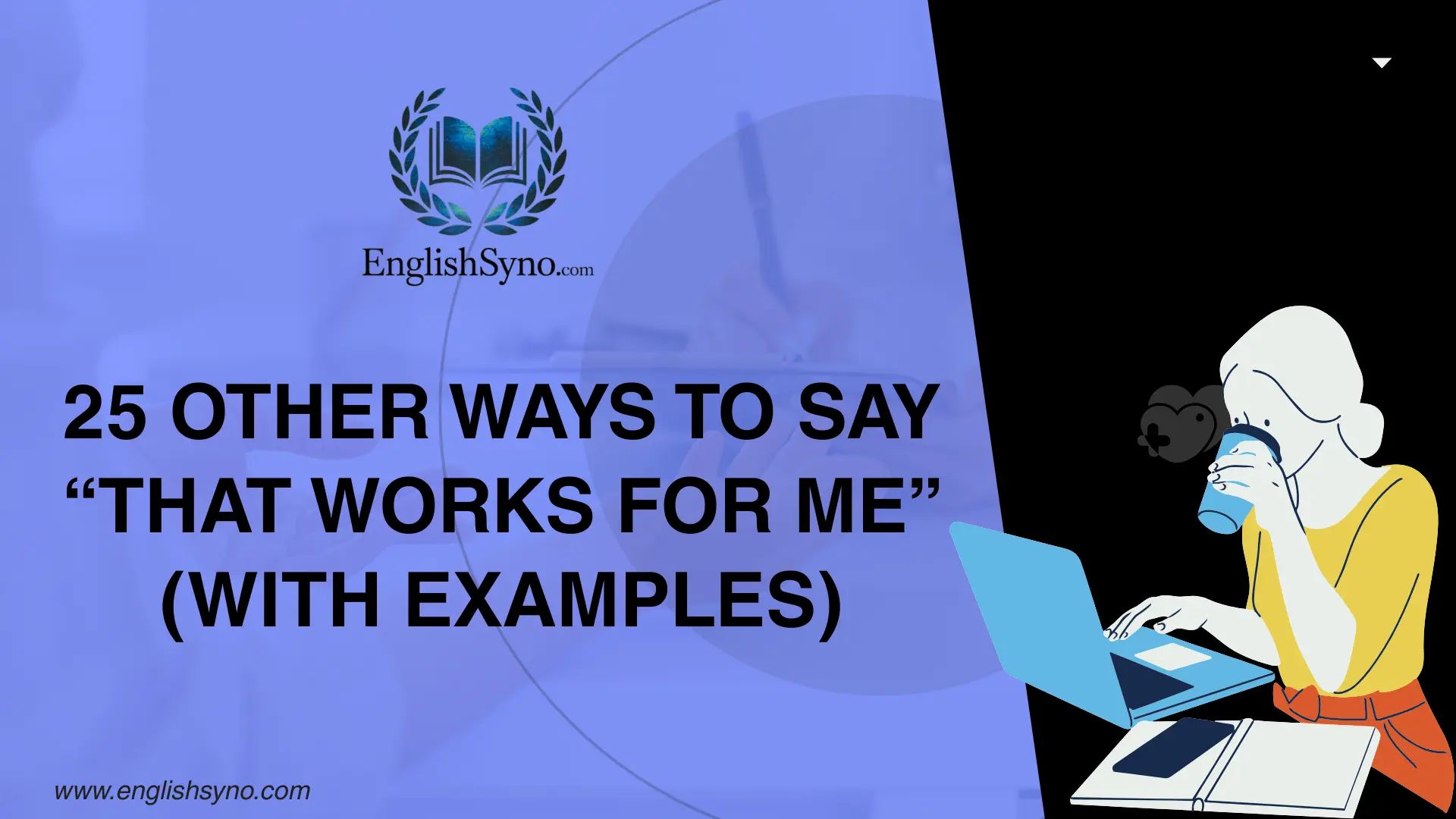When using the phrase that works for me in professional or casual settings, it’s a common, versatile way to agree with a plan or suggestion, like let’s meet at 3 p.m., and it confirms your understanding while keeping the tone polite.
This article provides twelve alternatives to help you choose the best way to say it, whether formal or informal, giving options that come in handy when a conversation falls into a gray area, ensuring stronger communications and the level of professionalism expected is met without seeming stiff.
What Does “that works for me” Mean?
The phrase “that works for me” indicates agreement, acceptance, or approval of a suggestion, plan, or idea. It communicates that the proposed arrangement is suitable, convenient, or acceptable to the speaker. Essentially, it’s a polite way to confirm alignment with someone’s plan or proposal.
When to Use “that works for me”
You can use “that works for me” in both personal and professional contexts when you want to acknowledge that a suggestion, plan, or timing suits you. It’s often used in emails, texts, meetings, and casual conversations to confirm flexibility or agreement without being overly formal.
Is It Professional/Polite to say “that works for me”?
Yes! It is both professional and polite, depending on the tone of the conversation. In formal settings, it’s best paired with a little extra context, such as:
“That works for me. I’ll make sure to prepare everything before our meeting.”
Pros or Cons
Pros:
- Simple and clear
- Polite and non-confrontational
- Shows flexibility and willingness
Cons:
- Can feel generic if overused
- Lacks emotional warmth or personality if used alone
That’s Perfect
Meaning & Explanation: Expresses that the arrangement or plan fits your needs exactly. Adds enthusiasm and positivity.
Email Example:
“Thank you for scheduling the call at 3 PM. That’s perfect-I’ll be ready with the updates.”
Best Use: When you are genuinely pleased with the arrangement.
Worst Use: When the arrangement is merely acceptable but not ideal.
Tone: Positive, enthusiastic, warm
Sounds Good
Meaning & Explanation: Casual, friendly way to convey agreement. Shows willingness without overcomplicating.
Email Example:
“Let’s meet on Thursday to review the project. Sounds good!”
Best Use: Informal work or personal conversations.
Worst Use: In highly formal communications, may seem too casual.
Tone: Friendly, relaxed, agreeable
hat Works
Meaning & Explanation: A shortened, concise version of the original phrase. Neutral but clear.
Email Example:
“We’ll start the training at 10 AM. That works.”
Best Use: Quick confirmations.
Worst Use: If you want to convey enthusiasm or gratitude.
Tone: Neutral, straightforward
All Set
Meaning & Explanation: Indicates readiness and approval. Implies you are prepared to proceed.
Email Example:
“Thanks for sending the agenda. All set on my end.”
Best Use: When confirming preparation or readiness.
Worst Use: When you need to express full agreement or emotional positivity.
Tone: Confident, efficient, agreeable
I’m Good With That
Meaning & Explanation: Casual and conversational. Suggests comfort and agreement with the plan.
Email Example:
“Meeting at 2 PM? I’m good with that.”
Best Use: Informal discussions with colleagues or friends.
Worst Use: Formal corporate settings.
Tone: Casual, relaxed, agreeable
That’s Fine
Meaning & Explanation: Neutral acceptance. Polite, though less enthusiastic.
Email Example:
“If you prefer Thursday for the review, that’s fine.”
Best Use: Situations requiring diplomacy without strong excitement.
Worst Use: When you need to show enthusiasm or encouragement.
Tone: Neutral, polite
Works for Me
Meaning & Explanation: Simplified version of the original phrase. Clear and concise.
Email Example:
“We’ll have lunch at noon. Works for me.”
Best Use: Quick confirmations.
Worst Use: Overly casual in formal settings.
Tone: Neutral, agreeable
That Fits My Schedule
Meaning & Explanation: Focuses on practical alignment with time or availability.
Email Example:
“Let’s plan for 11 AM. That fits my schedule.”
Best Use: Scheduling meetings or appointments.
Worst Use: In casual conversations where tone matters more than logistics.
Tone: Practical, professional
That’s Manageable
Meaning & Explanation: Indicates the proposal is feasible and within your capacity.
Email Example:
“Completing the draft by Friday? That’s manageable.”
Best Use: Professional or project-focused contexts.
Worst Use: Personal conversations needing warmth.
Tone: Professional, realistic, neutral
I Can Do That
Meaning & Explanation: Shows willingness and personal capability to follow through.
Email Example:
“You need me to present the slides tomorrow? I can do that.”
Best Use: Personal or work commitments.
Worst Use: If you are hesitant or unable to commit fully.
Tone: Helpful, willing, proactive
That’s Acceptable
Meaning & Explanation: Polite confirmation of agreement without strong enthusiasm.
Email Example:
“Your suggestion for the layout is acceptable.”
Best Use: Formal agreements.
Worst Use: When trying to appear excited or friendly.
Tone: Formal, professional, neutral
That’s Agreed
Meaning & Explanation: Confirms mutual understanding and consent.
Email Example:
“We’ll finalize the report by Monday. That’s agreed.”
Best Use: Formal or contractual confirmations.
Worst Use: Casual interactions.
Tone: Professional, serious, concise
Works Well
Meaning & Explanation: Indicates the arrangement is suitable and effective.
Email Example:
“Scheduling the review for Tuesday works well.”
Best Use: Professional emails or structured planning.
Worst Use: Informal texts to friends may sound stiff.
Tone: Positive, professional
That’s Convenient
Meaning & Explanation: Highlights that the proposed plan is easy or suitable for you.
Email Example:
“Meeting at 3 PM is convenient. See you then.”
Best Use: Professional or polite contexts.
Worst Use: Overused casually, may sound formal.
Tone: Polite, considerate
I’m Fine With That
Meaning & Explanation: Suggests agreement and comfort with the plan.
Email Example:
“If you want to reschedule the call to Friday, I’m fine with that.”
Best Use: Casual agreements.
Worst Use: Formal contexts where stronger confirmation is needed.
Tone: Friendly, relaxed
That Sounds Like a Plan
Meaning & Explanation: Adds a collaborative and enthusiastic tone.
Email Example:
“We’ll update the proposal and send it tomorrow. That sounds like a plan!”
Best Use: Team projects or collaborative efforts.
Worst Use: Extremely formal communications.
Tone: Enthusiastic, cooperative
Perfect Timing
Meaning & Explanation: Emphasizes that the arrangement is not just suitable, but timely.
Email Example:
“You’ll be available at 10 AM? Perfect timing-I’ll be ready.”
Best Use: Scheduling or events.
Worst Use: Situations where timing is irrelevant.
Tone: Positive, warm, enthusiastic
That’s Reasonable
Meaning & Explanation: Expresses agreement based on logic or practicality.
Email Example:
“Asking for a two-week deadline is reasonable. I can adjust accordingly.”
Best Use: Negotiations or logical discussions.
Worst Use: Emotional or casual settings.
Tone: Rational, professional
I’m On Board
Meaning & Explanation: Shows active participation and approval. Collaborative tone.
Email Example:
“We’re starting the new marketing strategy next week. I’m on board.”
Best Use: Team projects and initiatives.
Worst Use: Overly casual for formal contracts.
Tone: Enthusiastic, supportive
Works Like a Charm
Meaning & Explanation: Expresses that the plan or solution is effective and smooth.
Email Example:
“Testing the new software schedule at 2 PM works like a charm.”
Best Use: Positive reinforcement.
Worst Use: Formal corporate settings; too casual.
Tone: Cheerful, confident
That’s Ideal
Meaning & Explanation: Indicates the arrangement meets your needs perfectly.
Email Example:
“Meeting at 9 AM tomorrow? That’s ideal.”
Best Use: Expressing enthusiasm professionally.
Worst Use: Casual contexts may seem stiff.
Tone: Professional, positive
I’m Happy With That
Meaning & Explanation: Conveys emotional satisfaction along with agreement.
Email Example:
“Your suggested approach for the project? I’m happy with that.”
Best Use: Personal or friendly professional contexts.
Worst Use: Extremely formal or neutral communications.
Tone: Warm, agreeable, empathetic
Works Out
Meaning & Explanation: Suggests that the plan will proceed smoothly.
Email Example:
“We can shift the meeting to 11 AM. That works out.”
Best Use: Informal scheduling.
Worst Use: Overly formal situations.
Tone: Casual, optimistic
That’s Settled
Meaning & Explanation: Communicates finality and agreement.
Email Example:
“We’ll go ahead with the Thursday timeline. That’s settled.”
Best Use: Concluding discussions professionally.
Worst Use: Casual or friendly conversations; may seem abrupt.
Tone: Formal, conclusive, decisive
Fine by Me
Meaning & Explanation: Casual acceptance indicating flexibility and agreement.
Email Example:
“Switching the meeting to 3 PM? Fine by me.”
Best Use: Friendly or casual professional contexts.
Worst Use: Formal corporate emails; may sound too casual.
Tone: Casual, flexible, relaxed
Final Thoughts
Expressing agreement or approval in a meaningful way can have a significant impact on communication. While “that works for me” is simple and clear, exploring alternatives allows you to convey warmth, thoughtfulness, and personal connection. Choosing the right phrase depends on context, tone, and audience. Casual expressions like “sounds good” or “fine by me” are perfect for informal conversations, while professional alternatives like “that fits my schedule” or “that’s reasonable” show clarity and respect in work settings.
Using varied expressions prevents your communication from becoming repetitive and bland, enhancing your credibility and empathy. It signals attentiveness to the other person’s suggestions while maintaining clarity. Additionally, certain alternatives, such as “I’m on board” or “that works like a charm,” add enthusiasm and positivity, making interactions more engaging.
Ultimately, communication is not just about confirming plans-it’s about connecting with people in a way that feels considerate and human. By consciously selecting phrases that reflect your intent and tone, you improve relationships, foster collaboration, and convey confidence and attentiveness. Whether you’re writing emails, texting, or speaking in meetings, these alternatives equip you to respond in ways that are professional, empathetic, and personable. Experimenting with these options helps you strike the right balance between efficiency and warmth, making your messages not only functional but memorable. Thoughtful phrasing enhances clarity, builds rapport, and shows respect, making your communication more effective and meaningful.
FAQs About “That Works for Me”
What does “that works for me” mean?
It means you agree with a plan, suggestion, or idea and find it acceptable. It conveys alignment, convenience, and approval in both personal and professional contexts.
Is “that works for me” formal?
It’s neutral-appropriate for professional and casual use. Pairing it with context or additional information makes it sound more formal.
Can I use “sounds good” instead?
Yes, “sounds good” is casual and friendly, best for informal emails, messages, or team discussions. Avoid in highly formal settings.
How can I make it sound more enthusiastic?
Use alternatives like “that’s perfect,” “works like a charm,” or “I’m on board” to convey excitement and positivity.
Is it polite to say “fine by me”?
Yes, it’s polite and indicates flexibility, but it is more casual than “that fits my schedule” or “that’s acceptable.”
When should I use “I can do that”?
Use it when confirming personal willingness or capability to follow through on a plan or task.
Are there professional alternatives?
Yes. Examples include “that fits my schedule,” “that’s reasonable,” or “that’s acceptable,” which work well in corporate communications.
What’s the difference between “that works” and “that works for me”?
Both indicate agreement, but “that works for me” is slightly more personal and context-specific. “That works” is shorter and neutral.
Can these phrases be used in emails?
Absolutely. Most alternatives can fit email communication; tone should match formality and context.
Is “I’m happy with that” suitable for work?
Yes, it’s warm and conveys agreement, particularly in collaborative or friendly professional environments.
How do I show enthusiasm professionally?
Use “that’s ideal” or “that sounds like a plan”-they convey positivity while remaining professional.
Can I use multiple alternatives together?
Yes. Pairing expressions like “that works perfectly, sounds good to me” can add clarity and warmth.
Are these phrases culturally universal?
Most English-speaking cultures understand these expressions, though tone and formality may vary regionally.
Can these alternatives help build rapport?
Yes. Thoughtful phrasing demonstrates attentiveness and empathy, strengthening both personal and professional relationships.
Should I always vary my language?
Yes. Varying your expressions prevents monotony, adds personality, and helps tailor your tone to different audiences.



